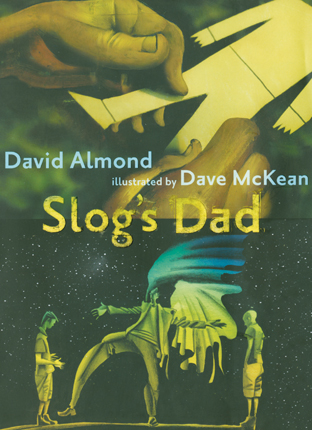Full Text Reviews: Booklist - 03/15/2011 The creative team behind The Savage (2008) pair up again for another work chiseled out of the raw material of hard, deep feelings of loss. Two Australian boys, Slog and the narrator, Davie, are on their way to pick up a couple of sandwiches when Slog spots a man sitting on a bench. Davie recounts the painful fashion in which Slog’s dad died after losing both of his legs and how he promised his son that when he gets his legs back in heaven, “I’ll walk straight out of them pearly gates . . . right back here to the lovely earth.” Slog is convinced this man is his father come back, but Davie doesn’t brook such illusions. Almond’s understated, magic-realism-tinged story trades licks with McKean’s distinctive artwork, a few pages of prose followed by a few pages of multiformat imagery that doesn’t so much illustrate the proceedings as reflect and explore the depths of grief, longing, and hope swirling about a boy’s last chance to say good-bye to his father. With understated and uncommon wisdom, Almond and McKean wring a bit of hope out of the toughest of emotions. - Copyright 2011 Booklist. Bulletin for the Center... - 05/01/2011 Slog’s dad, a hymn-singing garbage collector, was smelly but beloved in his small English village. Cancer slowly deprived him of his limbs but not his spirit, and when he died, he promised his son that he would return to him in the spring. Slog is not surprised, then, when he and his friend Davie, the book’s narrator, one day see a man sitting on a park bench whom Slog immediately identifies as his dad. Davie is as wary as he is skeptical, but the man answers every testing question correctly; Davie’s doubt turns to wonder while Slog’s faith is confirmed, and the man then disappears into the crowd. In the hybrid style of text interspersed with illustrative sequences that author and illustrator employed in The Savage (BCCB 3/09), this grief-strafed wonder tale is brilliantly matched by some of McKean’s most moving artwork yet. Text pages, featuring a voice steeped in Northern English flavor, are counterpoised against wordless illustration sequences that move readers from heaven to earth and back again, beginning with a celestial descent from the sky to a park bench by a man trailing clouds of watercolor glory. The spidery linework that depicts the man on the bench highlights his insubstantiality, while denser, more earthy digital collage brings us Slog in his grief, trying to come to terms with his father’s loss by cutting the legs off a paper doll and taping them back on again, dreaming his father as an angel and a superhero, and crafting an effigy that ultimately blesses his father’s trip back to heaven. The layered, imagination-rich visuals are balanced by Slog’s Doubting Thomas–like need to touch his father’s resurrected legs, effectively encapsulating Almond’s recurrent theme of faith that treads tenuously and triumphantly between spirit and substance. KC - Copyright 2011 The Board of Trustees of the University of Illinois. School Library Journal - 05/01/2011 Gr 5–8—The spring after Davie's friend Slog loses his father, the two boys encounter a man on a bench whom Slog believes to be his dad, returned from heaven. The narrative then recounts the man's illness, which included multiple amputations, and his death. Originally written as a short prose piece, Almond's story has been not so much illustrated, but framed and given visual sequences that amplify and reinforce the boy's grief. McKean combines paint, photography, and some digital manipulation to create some very tonal and evocative extensions. This technique is effective, but it also makes the collaboration more emotionally abstract than a simple story. But complexity and abstraction can also engender ambiguity, and it's difficult to say for certain how readers are supposed to feel about the doubts Davie expresses about Slog's dad's veracity, or the way that Almond mixes the mundane and the supernatural. The Savage (Candlewick, 2008), the pair's earlier collaboration, was a fairly clear-cut tale of magical realism, identity, and wish-fulfillment, but the focus on mourning here makes the resolution more difficult to pin down. There's an honesty to it, just as there is a raw, emotive honesty to McKean's illustrations, even if it's sometimes delayed until the context for them comes like a punch in Almond's next text section. This is a strangely incomplete, but fascinating work that may leave readers uncomfortable with the sudden ending. But for those who have dealt with the lack of closure that intertwines with loss, this will be a particularly resonant book.—Benjamin Russell, Belmont High School, NH - Copyright 2011 Publishers Weekly, Library Journal and/or School Library Journal used with permission. Loading...
|



